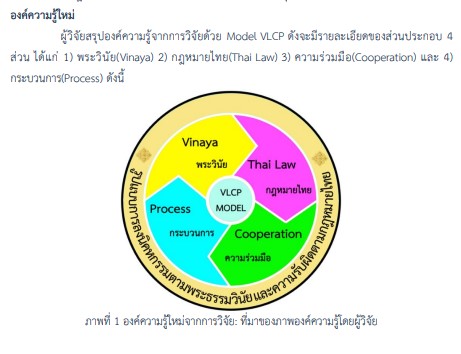A Model of Punishment in Buddhist Discipline and Legal Liability in Thai Law
Main Article Content
Abstract
This dissertation has 3 objectives: 1) to study the principles and methods of suppression based on the Dhamma-Vinaya in the Buddhist scriptures and Thai law 2) to analyze problems of suppression according to the Sangha Act, 2505 and Thai Code of Law on liability and 3) to propose Dharma-Vinaya suppression (Niggahakamma) and Thai law liability model. This is qualitative research by studying documents and in-depth interviews with small group discussion, a total of 22 informants including non-participatory observations. The collected data were analyzed and presented by an analytical description. The research findings revealed that:
1) The Vinaya Pitaka suppression is authorised and set guidelines to Sangha by the Buddha whenever conflict occurs. The Buddha set the guidelines for the monks to follow (Adhikaranasamatha 7) for trial and suppression so that the accused monks could prove their innocence. This is for the fairness of all parties and the opportunity to repent and later on return to the monastic community. However, suppression under Thai law is a process that focuses on proving facts and forces imprisonment if monk does not accept the verdict without participation of the monk in the trial.
2) Problems and hindrances of the current law of suppression process are: (1) problem of knowledge of dharma discipline (2) problem of structure of the Sangha Act (3) problem of legislation and interpretation and (4) problem of process and procedures in practice.
3) The model for Punishment in Buddhist Discipline and Legal Liability in Thai Law is VLCP Model which derived from 4 principles as follows: (1) Vinaya: the application of the Dharma-Vinaya is an important consideration (2) Thai Law: conduct, trial and suppress in accordance with Dharma-Vinaya (3) Co-operation: the Buddhist Sangha administration and the nation administration jointly solve problems and propose solutions completely and carefully and (4) Process: conduct suppression correctly according to the Dhamma-Vinaya without violating the principles of Thai law from the time complaint is filed until final judgement in order to ensure accuracy, fairness and mutual benefit.
Article Details

This work is licensed under a Creative Commons Attribution-NonCommercial-NoDerivatives 4.0 International License.
เรื่องลิขสิทธิ์/เป็นความคิดเห็นของผู้เขียน
References
หนังสือ
กรมการศาสนา. (2559). คู่มือพระสังฆาธิการ. กรุงเทพมหานคร: โรงพิมพ์สำนักงานพระพุทธศาสนาแห่งชาติ.
คณาจารย์ มหาวิทยาลัยมหาจุฬาลงกรณราชวิทยาลัย. (2559). พระพุทธศาสนากับการเมืองการปกครอง. กรุงเทพมหานคร: โรงพิมพ์มหาจุฬาลงกรณราชวิทยาลัย.
ปวริศร เลิศธรรมเวที, (2564). สิทธิทางรัฐธรรมนูญ (Constitutional Rights). พิมพ์ครั้งที่ 2. กรุงเทพมหานคร: สำนักพิมพ์นิติธรรม.
มหาจุฬาลงกรณราชวิทยาลัย. (2560). พระไตรปิฎกภาษาไทย ฉบับมหาจุฬาลงกรณราชวิทยาลัย. กรุงเทพมหานคร: โรงพิมพ์มหาจุฬาลงกรณราชวิทยาลัย.
สมเด็จพระพุทธโฆษาจารย์ (ป.อ.ปยุตฺโต). (2560). นิติศาสตร์แนวพุทธ. พิมพ์ครั้งที่ 20. กรุงเทพมหานคร: โรงพิมพ์เดือนตุลา.
สื่ออิเล็กทรอนิกส์
สำนักงานคณะกรรมการกฤษฎีกา. พระราชบัญญัติคณะสงฆ์ พ.ศ. 2505. [ออนไลน์]. แหล่งที่มา: http://web.krisdika.go.th. (วันที่สืบค้น 6 กรกฎาคม 2565).
อัมรินทร์ทีวี. ภาวนาพุทโธ คัมแบ็ก! ผุดฉายาพ่อมังกรห่มสีรุ้ง อึ้งสงฆ์แห่ไหว้ พศ.ยันไม่ผิด. [ออนไลน์]. แหล่งที่มา: https://www.amarintv.com (วันที่สืบค้น 25 กันยายน 2565).
Pew Research Center. Young adults around the world are less religious by several measures. [ออนไลน์]. แหล่งที่มา: https://www.pewresearch.org. (วันที่สืบค้น 6 กรกฎาคม 2565).


